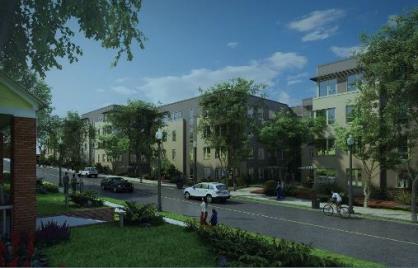
Washington City Paper by Andrew Giambrone
For the first time in almost four years, a District-wide effort to replace deteriorating public housing with mixed-income apartments and other amenities saw some action Tuesday in Ward 7's Deanwood neighborhood.
Mayor Muriel Bowser and planning officials broke ground that morning on the Deanwood Hills Apartments, located at 5201 Hayes St. NE, near the intersection of Nannie Helen Burroughs and Division avenues. The $35 million project promises 150 units of affordable housing, from studio to four-bedroom apartments, spread across four floors. It will feature "a multi-purpose room, exercise facility, community tot lot, courtyard lawn and patio, game room, and a cyber cafe," according to the development team's application with the D.C. Zoning Commission, filed last August. That application—for a planned unit development—was subsequently approved.
Deanwood Hills is part of the longstanding New Communities Initiative. Launched more than a decade ago, the initiative is now notorious for taking longer than expected to get projects off the ground, in part because of the 2008 recession and individual site factors. Three other NCI redevelopments are in Wards 1, 6, and 8, and are at various stages of progress.
The goal is to make distressed public housing both habitable and financially sustainable,based on residents' so-called "right to return." Since federal investments in subsidized housing have shrunk in recent decades, mixed-income projects are seen as a way to ensure enough rental income for maintaining units where tenants pay well below market rate.Roughly 1,500 older public housing units will be demolished as part of the initiative.
A key NCI principle is to minimize the risk of displacing residents by following a "build-first" model. That means off-site "replacement units" should be available to those living in existing public housing buildings slated for redevelopment, before construction work begins. The model is intended to preserve low-income households' choice of where to live, within certain constraints.
The new Deanwood project presents an example of how this plays out. Fifty of the units at Deanwood Hills will become replacement units for public housing residents at both the Lincoln Heights and Richardson Dwellings developments, which together contain 600 occupied and 30 boarded-up units, all slotted for redevelopment. The reconstruction of the latter two properties will proceed in phases.
Overall, there are five phases for the Ward 7 NCI program that set the order for relocating tenants. The first phase covers 54 units at Lincoln Heights, the second phase covers 52 more units there, and so on. The entire Richardson Dwellings falls under the fifth phase. (The District has not yet solicited a redevelopment team for the Lincoln and Richardson properties. The "master plan" for refurbishing the sites will ultimately require D.C. Zoning Commission and federal approval.)
Once residents who live in a certain phased-segment of Lincoln Heights or Richardson Dwellings move into their replacement units, the empty buildings can be razed and built back to higher density than before with infrastructure improvements.
The future Strand Development site on Nannie Helen Burroughs Avenue NE is also expected to include replacement units—about 28 out of 86 apartments. (The D.C. Council is currently considering legislation to approve the disposition of land needed for that project.) A handful of other properties in the neighborhood already have replacement units, such as 4800 Nannie Helen Burroughs, The Marley Ridge, and 4427 Hayes St. NE.
Families who decide not to relocate to an off-site project will have "other options typical in a public housing redevelopment scenario," a D.C. planning official says, including moving to a D.C. Housing Authority property in another neighborhood, taking low-income vouchers for alternative housing, and working with "relocation specialists."
Some public housing residents are concerned that despite assurances, they'll face pressure to leave their homes and won't be able to come back. This has been the case in Barry Farm, the NCI redevelopment in Ward 8, in particular. It has the highest vacancy rate of any NCI site, and community activists have staged protests and demonstrations, highlighting tenants' fears that they're being pushed out to make way for more affluent residents.
The last time an NCI project saw progress on the scale of a groundbreaking was in December 2012, at the Severna on K building. It replaced public housing at Temple Courts, a spokesman for the Deputy Mayor for Planning and Economic Development says.
The affordability breakdown of the Deanwood Hills Apartments—based on an area median income of $109,000 for a family of four—is as follows:
- 40 replacement units reserved for families making no more than 30 percent of AMI
- 10 replacement units reserved for families making no more than 60 percent of AMI
- 100 remaining units reserved for families making no more than 60 percent of AMI
Deanwood Hills will offer 75 free parking spaces on a first-come first-served basis. It's being financed through $17 million in short- and long-term tax-exempt obligations from the D.C. Housing Finance Agency, $14 million through low-income housing tax equity, a $9.5 million NCI loan by DMPED, a $2 million DCHA loan, and other funds.
The project's development team consists of Pennrose Properties, LLC and the Warrington Group. Torti Gallas Urban is handling the redevelopment's design. The building is expected to open in spring 2018.


